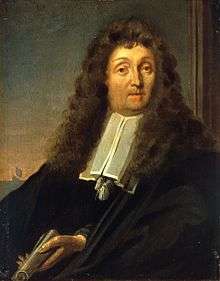Ludolf Bakhuizen

Ludolf Bakhuizen (28 December 1630 – 17 November 1708), also spelled Backhuysen[1] and Backhuisen,[2] was a German-born Dutch Golden Age painter who was the leading Dutch painter of maritime subjects after the two Willem van de Veldes (father and son) left for England in 1672.
Life
He was born in Emden, East Frisia, and came to Amsterdam in about 1650, working as a merchant's clerk and a calligrapher.[3] He discovered so strong a genius for painting that he relinquished the business and devoted himself to art from the late 1650s, initially in pen drawings. He studied first under Allart van Everdingen and then under Hendrik Dubbels, two eminent masters of the time, and soon became celebrated for his sea-pieces, which often had rough seas.[2]
He was an ardent student of nature, and frequently exposed himself on the sea in an open boat in order to study the effects of storms. His compositions, which are numerous, are nearly all variations of one subject, the sea, and in a style peculiarly his own, marked by intense realism or faithful imitation of nature. In his later years Bakhuizen employed his skills in etching; he also painted a few examples each of several other genres of painting, such as portraits, landscapes and genre paintings.[2]
During his life Bakhuizen was visited by Cosimo III de' Medici, Peter the Great and also worked for various German princes. In 1699 he opened a gallery on the top floor of the famous Amsterdam townhall. After a visit to England he died in Amsterdam on 17 November 1708.[2]
Gallery
 Bakhuizen, Ludolf ~ The Y at Amsterdam viewed from Mussel Pier, 1673, oil on canvas, Rijksmuseum, Amsterdam
Bakhuizen, Ludolf ~ The Y at Amsterdam viewed from Mussel Pier, 1673, oil on canvas, Rijksmuseum, Amsterdam Ships Running Aground in a Storm by Ludolf Bakhuizen 1690s Oil on canvas, 173,5 x 341 cm Musées Royaux des Beaux-Arts, Brussels
Ships Running Aground in a Storm by Ludolf Bakhuizen 1690s Oil on canvas, 173,5 x 341 cm Musées Royaux des Beaux-Arts, Brussels Battle of Vigo Bay by Ludolf Bakhuizen 1702
Battle of Vigo Bay by Ludolf Bakhuizen 1702
References
Citations
- ↑ EB (1878).
- 1 2 3 4 EB (1911).
- ↑ Ludolf Bakhuizen biography in De groote schouburgh der Nederlantsche konstschilders en schilderessen (1718) by Arnold Houbraken, courtesy of the Digital library for Dutch literature
Bibliography
- "Ludolf Backhuysen", Encyclopædia Britannica, 9th ed., Vol. III, New York: Charles Scribner's Sons, 1878, p. 200.
- "Ludolf Backhuysen", Encyclopædia Britannica, 11th ed., Vol. III, Cambridge: Cambridge University Press, 1911, p. 135.
- MacLaren, Neil (1991), The Dutch School, 1600–1800, Vol. I, National Gallery Catalogues, London: National Gallery, ISBN 0-947645-99-3.
External links
- Works and literature on Ludolf Bakhuizen
- "Ships in Distress in a Heavy Storm", Rijksmuseum
- Vermeer and The Delft School, a full text exhibition catalog from The Metropolitan Museum of Art, which contains material on Ludolf Bakhuizen
- 61 Paintings by Ludolf Bakhuizen at the Art UK site
| Wikimedia Commons has media related to Ludolf Bakhuizen. |